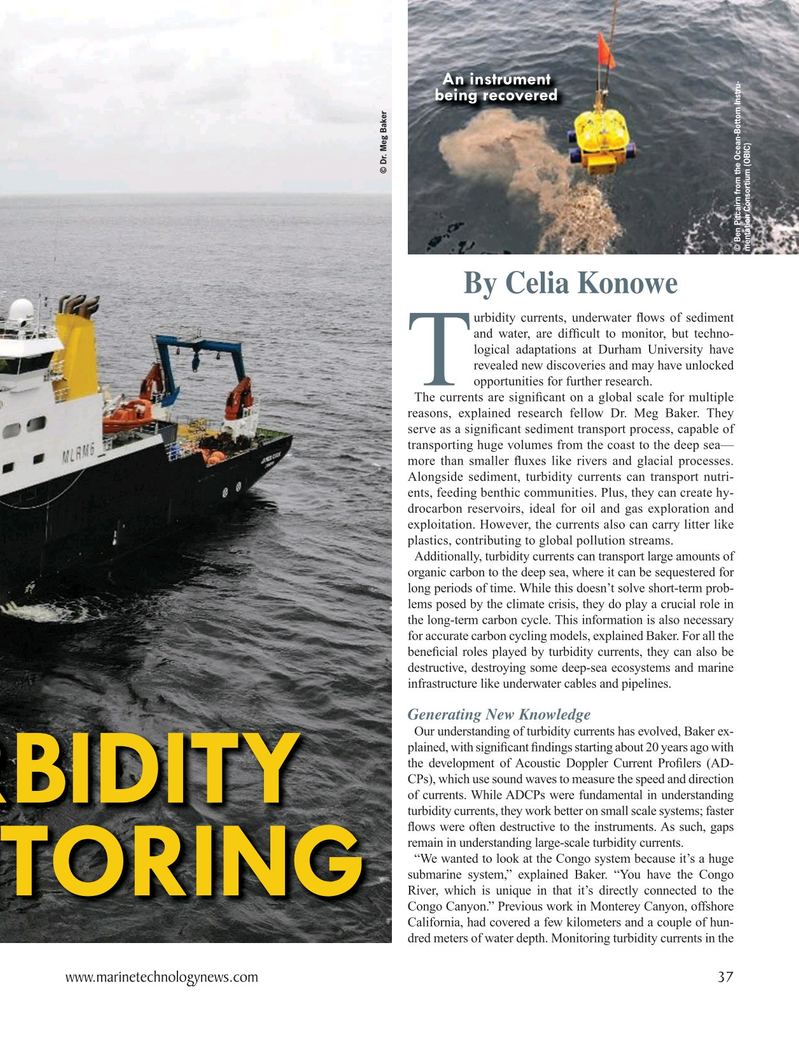
Page 37: of Marine Technology Magazine (March 2025)
Read this page in Pdf, Flash or Html5 edition of March 2025 Marine Technology Magazine
An instrument being recovered © Dr. Meg Baker © Ben Pitcairn from the Ocean-Bottom Instru- mentation Consortium (OBIC)
By Celia Konowe urbidity currents, underwater ? ows of sediment and water, are dif? cult to monitor, but techno- logical adaptations at Durham University have revealed new discoveries and may have unlocked
T opportunities for further research.
The currents are signi? cant on a global scale for multiple reasons, explained research fellow Dr. Meg Baker. They serve as a signi? cant sediment transport process, capable of transporting huge volumes from the coast to the deep sea— more than smaller ? uxes like rivers and glacial processes.
Alongside sediment, turbidity currents can transport nutri- ents, feeding benthic communities. Plus, they can create hy- drocarbon reservoirs, ideal for oil and gas exploration and exploitation. However, the currents also can carry litter like plastics, contributing to global pollution streams.
Additionally, turbidity currents can transport large amounts of organic carbon to the deep sea, where it can be sequestered for long periods of time. While this doesn’t solve short-term prob- lems posed by the climate crisis, they do play a crucial role in the long-term carbon cycle. This information is also necessary for accurate carbon cycling models, explained Baker. For all the bene? cial roles played by turbidity currents, they can also be destructive, destroying some deep-sea ecosystems and marine infrastructure like underwater cables and pipelines.
Generating New Knowledge
Our understanding of turbidity currents has evolved, Baker ex- plained, with signi? cant ? ndings starting about 20 years ago with the development of Acoustic Doppler Current Pro? lers (AD-
CPs), which use sound waves to measure the speed and direction of currents. While ADCPs were fundamental in understanding
RBIDITY turbidity currents, they work better on small scale systems; faster ? ows were often destructive to the instruments. As such, gaps remain in understanding large-scale turbidity currents.
“We wanted to look at the Congo system because it’s a huge submarine system,” explained Baker. “You have the Congo
River, which is unique in that it’s directly connected to the
ITORING
Congo Canyon.” Previous work in Monterey Canyon, offshore
California, had covered a few kilometers and a couple of hun- dred meters of water depth. Monitoring turbidity currents in the www.marinetechnologynews.com 37
MTR #3 (34-49).indd 37 3/13/2025 11:47:19 AM

 36
36

 38
38
